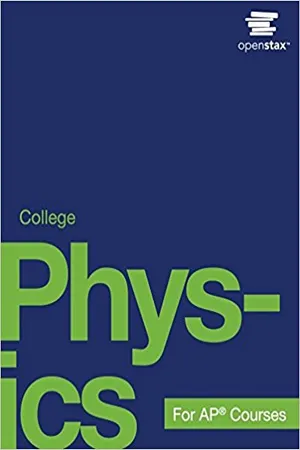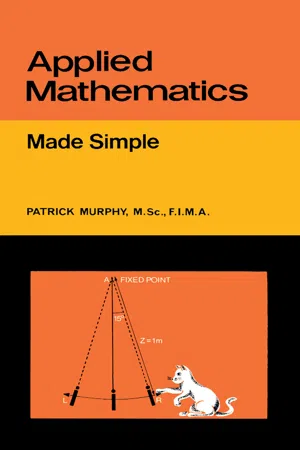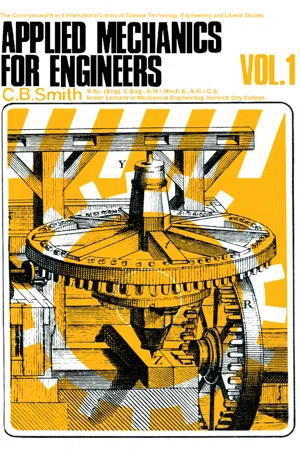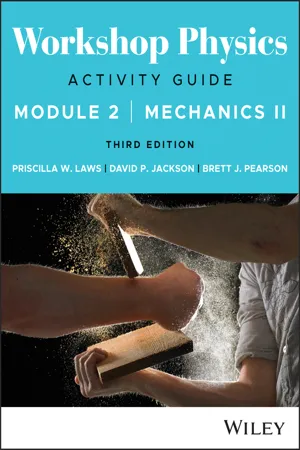Physics
Angular Work and Power
Angular work and power are concepts that relate to rotational motion. Angular work is the product of the torque applied to an object and the resulting angular displacement, while angular power is the rate at which work is done. These concepts are important in understanding the transfer of energy and the performance of rotating systems.
Written by Perlego with AI-assistance
Related key terms
1 of 5
9 Key excerpts on "Angular Work and Power"
- eBook - PDF
- Paul Peter Urone, Roger Hinrichs(Authors)
- 2012(Publication Date)
- Openstax(Publisher)
So, while the analogies are precise, these rotational quantities depend on more factors. 10.4 Rotational Kinetic Energy: Work and Energy Revisited In this module, we will learn about work and energy associated with rotational motion. Figure 10.14 shows a worker using an electric grindstone propelled by a motor. Sparks are flying, and noise and vibration are created as layers of steel are pared from the pole. The stone continues to turn even after the motor is turned off, but it is eventually brought to a stop by friction. Clearly, the motor had to work to get the stone spinning. This work went into heat, light, sound, vibration, and considerable rotational kinetic energy. Figure 10.14 The motor works in spinning the grindstone, giving it rotational kinetic energy. That energy is then converted to heat, light, sound, and vibration. (credit: U.S. Navy photo by Mass Communication Specialist Seaman Zachary David Bell) Work must be done to rotate objects such as grindstones or merry-go-rounds. Work was defined in Uniform Circular Motion and Gravitation for translational motion, and we can build on that knowledge when considering work done in rotational motion. The simplest rotational situation is one in which the net force is exerted perpendicular to the radius of a disk (as shown in Figure 10.15) and remains perpendicular as the disk starts to rotate. The force is parallel to the displacement, and so the net work done is the product of the force times the arc length traveled: (10.53) net W = (net F)Δs. To get torque and other rotational quantities into the equation, we multiply and divide the right-hand side of the equation by r , and gather terms: (10.54) net W = (r net F) Δs r . We recognize that r net F = net τ and Δs / r = θ , so that (10.55) net W = (net τ)θ. This equation is the expression for rotational work. It is very similar to the familiar definition of translational work as force multiplied by distance. - eBook - PDF
- William Bolton(Author)
- 2016(Publication Date)
- Newnes(Publisher)
Hence Figure 12.1 Work being done as a result of rotation work done per second = T x 2 / = 7 where is the angular velocity. 182 Engineering Science Power The rate at which energy is transferred is called power, hence where the energy is transferred as a result of work, the power is the rate of doing work. The unit of power is the watt (W), where 1 W = 1 J/s. For an object on which work is done for a time / and results in a displace-ment s in that time, W Fs _ power = — = — = Fv t t where v is the velocity. Example 1 The locomotive of a train exerts a constant force of 120 kN on a train while pulling it at 40 km/h along a level track. What is (a) the work done in 15 minutes and (b) the power? (a) In 15 minutes the train covers a distance of 10 km. Hence work done = 120 x 10 3 x 10 x 10 3 = 1.2 x 10 9 J (b) Power is the rate of work being done; hence 120 x 10 3 x 40 x 10 3 Λ . 1 6 117 Λ . ..... power = = 1.3 x 10 6 W = 1.3 MW 60 x 60 Example 2 Calculate the power a car must exert if it is to maintain a constant velocity of 30 m/s when the resisting forces amount to 4.0 kN. As above, power = Fv = 4.0 x 10 3 x 30 = 120 x 10 3 W = 120 kW Example 3 What power must be developed by the motor of a tractor of mass 800 kg which pulls a trailer of mass 300 kg up a 10° incline at 10 m/s if the resistance to motion amounts to 500 N? The component of the weight of tractor plus trailer down the plane is 1100 x 9.8 x sin 10°. Thus the total force acting down the plane is F= 1100x9.8xsin 10° + 500 = 2372 N Hence power = Fv = 2372 x 10 = 23.72 x 10 3 W = 23.72 kW Energy 183 Example 4 What power will be required for a pump to extract water from a mine at 5 mVs and pump it through a vertical height of 20 m? Water has a density of 1000 kg/m 3 . As power is the rate of doing work power = y = 5 x 1000 x 9.8 x 20 = 980 x 10 3 W = 980 kW Example 5 A constant torque of 50 N m is used to keep a flywheel rotating at a constant 5 revolutions per second. - eBook - PDF
- John D. Cutnell, Kenneth W. Johnson, David Young, Shane Stadler(Authors)
- 2018(Publication Date)
- Wiley(Publisher)
Chapter 6 discusses their application to translational motion. These concepts are equally useful for rota- tional motion, provided they are expressed in terms of angular variables. TABLE 9.2 Analogies Between Rotational and Translational Concepts Physical Concept Rotational Translational Displacement s Velocity Acceleration a The cause of acceleration Torque Force F Inertia Moment of inertia I Mass m Newton’s second law Σ τ = Iα Σ F = ma Work τθ Fs Kinetic energy 1 2 Iω 2 1 2 mυ 2 Momentum L = Iω p = mυ F Rod (overhead view) F Axis (perpendicular to page) A F B C m m m m 2m 3m CYU FIGURE 9.6 242 CHAPTER 9 Rotational Dynamics The work W done by a constant force that points in the same direction as the displacement is W = Fs (Equation 6.1), where F and s are the magnitudes of the force and the displace- ment, respectively. To see how this expression can be rewritten using angular variables, consider Figure 9.20. Here a rope is wrapped around a wheel and is under a constant tension F. If the rope is pulled out a distance s, the wheel rotates through an angle = s/r (Equation 8.1), where r is the radius of the wheel and is in radians. Thus, s = r, and the work done by the tension force in turning the wheel is W = Fs = Fr. However, Fr is the torque applied to the wheel by the tension, so the rotational work can be written as follows: DEFINITION OF ROTATIONAL WORK The rotational work W R done by a constant torque in turning an object through an angle is W R = τθ (9.8) Requirement: must be expressed in radians. SI Unit of Rotational Work: joule (J) Section 6.2 discusses the work–energy theorem and kinetic energy. There we saw that the work done on an object by a net external force causes the translational kinetic energy ( 1 2 mυ 2 ) of the object to change. In an analogous manner, the rotational work done by a net external torque causes the rotational kinetic energy to change. - eBook - PDF
Applied Mathematics
Made Simple
- Patrick Murphy(Author)
- 2014(Publication Date)
- Butterworth-Heinemann(Publisher)
Work, Energy, and Power 217 CHAPTER TWELVE WORK, E N E R G Y A N D P O W E R (1) Work In applied mathematics, work is associated with the movement of bodies from one position to another. Since the movement of a body from rest re-quires force, and the change in position is represented by displacement, we shall define work by relating it to force and displacement. If you help to push-start a car with a flat battery on a winter's morning you will readily agree on three things : pushing the car 20 m will be only half the 'work' of pushing it 40 m ; directing your push in the line of motion is better than pushing in any other direction ; finally, the sooner you can find a down-ward slope the better. If a young child helps you push she will not do the same amount of work as you, even though she will move just as far. The differ-ence between your work contribution and hers will have something to do with the magnitude of the force applied to the car. We therefore conclude that a definition of work involving force and distance looks promising. In order to keep the early ideas as simple as possible we shall consider first, the work done by a force acting on a particle. DEFINITION : / / a constant force of magnitude Fis applied to a particle which then moves a distance s along the line of action of F, the product Fs is called work and is said to be a measure of the work done by the force on the particle. To measure anything we must have a standard unit. The search for a unit need only be brief because we have already obtained units for F and s. Since the standard units are newtons for F and metres for s, it follows that Fs must be measured in newton metres. Unfortunately this is the same measurement as for moment of a force, so it would be helpful to have some means of distinguishing between the two. We therefore refer to the newton metre, when it is a unit of work, as a joule (pronounced 'jewel'). - eBook - PDF
Applied Mechanics for Engineers
The Commonwealth and International Library: Mechanical Engineering Division
- C. B. Smith, N. Hiller, G. E. Walker(Authors)
- 2013(Publication Date)
- Pergamon(Publisher)
CHAPTER 6 Work, Power and Energy Work When a force acts on a body and causes it move, it is said to do work on the body. The work done by any moving force is the product of the average force and the distance through which the force moves in the direction of its line of action. EXAMPLE 6.1. If a load of 1 tonf is raised a height of 20 ft by a crane at constant velocity, then the force exerted by the crane on the load = 2240 lbf, the distance moved in the direction of this force is 20 ft and the work done on the load = 20 χ 2240 = 44,800 ft lbf of work. When measuring work, the units are expressed at ft lb of work to differentiate from a torque or moment which is stated as lbf ft. In some cases the line of action of the force does not coincide with the direction of motion and in such problems the force is divided up into a component in the direction of motion and one perpendicular to it. The work done by the force is then equal to the component of the force in the direction of motion χ distance moved. EXAMPLE 6.2. If a trolley is moved across a horizontal floor by a rope inclined at 30° to the horizontal and the tension in the rope is 40 lbf, find the work done in moving the trolley a distance of 10 ft. Component of force in direction of motion = 40 cos 30° = 40x0-866 = 34-64 lbf. 112 WORK, POWER AND ENERGY 113 Work done in moving trolley 10/f = 34-64 χ 10 = 346-4 ft lbf. In this case the vertical component of the 40 lbf, i.e. 40 sin 30° = 20 lbf merely tends to lift the trolley off the floor and reduce the load on the wheels. No work is done by this component of the force. Work done by a Rotating Torque Consider a tangential force FVof acting at a radius r ft. In one revolution, the distance moved by the force = 2nr ft and the work done = 2nr χ F ft lbf = 2nxFr = angle turned through 2π (radian) χ torque Fr (lbf ft). Therefore the work done by a torque Γ lbf ft rotating through an angle Θ radians = 0rft lbf of work. - eBook - PDF
Workshop Physics Activity Guide Module 2
Mechanics II
- Priscilla W. Laws, David P. Jackson, Brett J. Pearson(Authors)
- 2023(Publication Date)
- Wiley(Publisher)
However, it is perfectly valid to instead think of the work as W = F app (Δr cos ), which can be interpreted as finding the component of the displacement vector along the direc- tion of the force. In this case the component of the displacement vector along the direction of the force is simply the total height through which the box is lifted. The end result is that in this example, the work done is W = F app h = mgh, where h = Δr cos is the height the box is lifted. Thus, even if the box is being pushed up the ramp, the work done only depends on the vertical height the box is lifted. This is a particularly useful result, one that we will return to when we discuss gravitational potential energy. 2 It is critical to understand which angle is being referred to here. It is easy to get con- fused between the angle of the ramp and the angle between the force and displacement vectors. UNIT 10: WORK AND ENERGY 327 10.4 THE CONCEPT OF POWER Consider once again the three jobs described in the activities above. In addition to how much work it takes to do a job, it’s also important to consider how quickly the job can be completed. The more quickly the boxes get loaded, the sooner we can move on to the next job. In other words, the rate at which physical work can be done is also a relevant quantity, and this is what we call power. Just as we did with velocity and acceleration, we will consider both average and instantaneous quantities. The average power is the amount of work done divided by the time interval it takes to do the work ⟨P⟩ = W 1→2 Δt (10.5) If the work can be written a function of time, W = W(t), the instantaneous power is given by the time derivative of the work P = dW dt (10.6) We have seen that in SI units, work is measured in newton-meters (N ⋅ m), or joules (J). - eBook - PDF
- John D. Cutnell, Kenneth W. Johnson, David Young, Shane Stadler(Authors)
- 2015(Publication Date)
- Wiley(Publisher)
The large counterweight on the right side (short end) of this tall tower crane ensures its boom remains balanced on its mast while lifting heavy loads. It is not equal weights on both sides of the tower that keep it in equilibrium, but equal torques. Torque is the rotational analog of force, and is an important topic of this chapter. 9 | Rotational Dynamics Chapter | 9 LEARNING OBJECTIVES After reading this module, you should be able to... 9.1 | Distinguish between torque and force. 9.2 | Analyze rigid objects in equilibrium. 9.3 | Determine the center of gravity of rigid objects. 9.4 | Analyze rotational dynamics using moments of inertia. 9.5 | Apply the relation between rotational work and energy. 9.6 | Solve problems using the conservation of angular momentum. 9.1 | The Action of Forces and Torques on Rigid Objects The mass of most rigid objects, such as a propeller or a wheel, is spread out and not con- centrated at a single point. These objects can move in a number of ways. Figure 9.1a il- lustrates one possibility called translational motion, in which all points on the body travel on parallel paths (not necessarily straight lines). In pure translation there is no rotation of any line in the body. Because translational motion can occur along a curved line, it is often called curvilinear motion or linear motion. Another possibility is rotational motion, which may occur in combination with translational motion, as is the case for the somersaulting gymnast in Figure 9.1b. We have seen many examples of how a net force affects linear motion by causing an object to accelerate. We now need to take into account the possibility that a rigid object can also have an angular acceleration. A net external force causes linear motion to change, but what causes rotational motion to change? For example, something causes the rotational velocity of a speedboat’s propeller to change when the boat accelerates. - eBook - PDF
- Richard C. Hill, Kirstie Plantenberg(Authors)
- 2013(Publication Date)
- SDC Publications(Publisher)
Since the shafts are treated as massless, the moments applied to the shafts must balance about the rotation center O. That is, the motor torque M will be balanced by the moment due to the Conceptual Dynamics Kinetics: Chapter 8 – Rigid Body Work & Energy 8 - 9 normal forces, 2Nr. Also, each normal force N travels through a distance of s = r . Using these relationships and the fact that r is constant, the work equation becomes 2 2 2 2 1 1 1 1 1 2 2 1 2 2 ( ) ( ) s s i s s M M U d N ds ds d r M d M M r r r r F r Work-energy balance This system is not a conservative system due to the application of the motor torque. When calculating the kinetic energy of the system, note that both balls have the same mass and travel along the bar in a symmetric manner giving them equal speeds. 1 1 1 2 2 2 T V U T V 2 2 1 2 ,2 2 1 2 i i U m v mv The velocity of the balls may be written as v r . 2 2 2 ( ) M m r 2 1 2 M g r W Case 1: r = L/2 2 2 2 30 M g L W rad s Case 1: r = L 2 1 2 15 M g L W rad s The distance that the balls are from the center of rotation affects the angular speed that the system achieves. If the balls are further out from the center, it takes more energy to accelerate them to an equal angular speed as compared to when the balls are closer to the center. 8.2) WORK In the chapter on Particle Work and Energy, we learned that a force pushing or pulling an object through a distance does work. In the case of rigid bodies, this force can cause the body to translate as well as rotate. Despite the differences between particles and rigid bodies, the definition of work done by a force and its determination is the same whether that force is applied to a particle or a rigid body. Because rigid bodies can rotate as well as translate, sometimes it will be inconvenient to determine the distance over which the force acts. - eBook - PDF
- Joaquim A. Batlle, Ana Barjau Condomines(Authors)
- 2022(Publication Date)
- Cambridge University Press(Publisher)
What is the motor power? A 0 B 1=2 ð Þmgv 0 sin β C mgv 0 sin β D 3=2 ð Þmgv 0 sin β E 2mgv 0 sin β 5.43 The skater has a moment of inertia Ι 0 about the vertical direction through its center of mass G when her arms are stretched away. In that configuration, she spins with angular velocity Ω 0 relative to the ground. When she folds her arms, her spinning velocity doubles. Assuming that G does not change its position and that the frictions are negligible, what is the work developed by her muscles? A 3=2 ð ÞΙ 0 Ω 2 0 B 2Ι 0 Ω 2 0 C Ι 0 Ω 2 0 D 1=2 ð ÞΙ 0 Ω 2 0 E 0 5.44 The platform Q and the vertical smooth axis are mutually fixed, and they have an angular velocity ω relative to the ground (E). The platform P rotates freely initially with an angular velocity 3ω relative to E. Both platforms are homogeneous and have the same moment of inertia Ι about the vertical direction through their center of mass. Suddenly platform P falls on platform Q, and the friction between them stops their relative rotation. What is the work associated with that friction? A Ιω 2 B 2Ιω 2 C 4Ιω 2 D 8Ιω 2 E 0 W friction ? bearing 3 falls and sticks to platform Q g initially I I platform P platform Q smooth axis E W motor ? m g v 0 const. v E = 0 const. E W skater ? 0 G 2 0 initially finally negligible friction I O 375 Quiz Questions 5.45 A block moving on a frictionless horizontal ground (E) with speed v 0 reaches the surface of a moving truck (which is level with the ground). The friction between block and truck leads the block to a final stop relative to the truck. If the truck keeps a speed v 0 relative to the ground constant, what is the work developed by its motor? A 1=2 ð Þmv 2 0 B mv 2 0 C 2mv 2 0 D 4mv 2 0 E 0 5.46 A block moves on smooth horizontal ground and collides with a wall through a spring–damper system.
Index pages curate the most relevant extracts from our library of academic textbooks. They’ve been created using an in-house natural language model (NLM), each adding context and meaning to key research topics.








